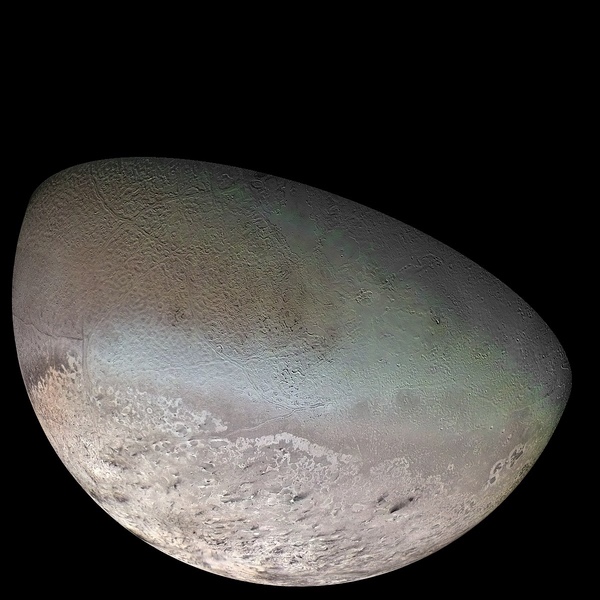 Triton’s surface is relatively smooth, with few craters. This indicates that it has been resurfaced and is geologically young. Before Voyager 2 flew past it in the late 1980s, conventional models of the solar system predicted that these outer moons should have been geologically uninteresting rocks. Not worlds with wind, ice, geysers, and possibly subsurface oceans. (credit: NASA) |
All the myriad worlds
by Dwayne Day
Monday, May 16, 2022
The other day I was having dinner with a prominent planetary scientist when I mentioned that I had a list of my five favorite moons. You do? He asked, surprised. Sure. Don’t you? He studies Venus, and Venus, like Vulcan, has no moon, so he didn’t have his own list of favorite moons but asked me to name mine. As I explained, most of my choices are not based strictly on scientific merit, but on the stories they tell—and the history of how we have discovered, studied, and explored them. Here they are, and why they’re on my list.
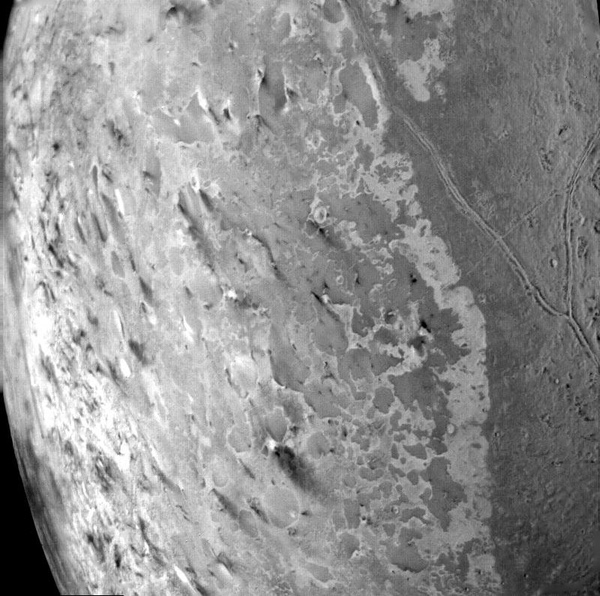 The black smudges on Triton are signs of cryovolcanism. They are pointed in a certain direction, indicating that winds are blowing them after the material is ejected from the surface. (credit: NASA) |
Triton
Back in 1989, Voyager 2 flew past Neptune, the last target on its trip out of the solar system and into the great beyond. As it approached Neptune, I don’t think people expected much. Voyager 2’s earlier encounter with Uranus had not excited a lot of people, perhaps because Uranus was just a hazy bluish-green orb.
| Triton could be the key to a new definition of where life can exist in the universe. |
But Neptune proved to be different. As Voyager got closer the planet appeared to be bluer, and prettier than Uranus. In the media, reporters waxed poetic about the alluring azure of this ice giant on the edges of our solar system, clearly captivated by it.
Then Voyager detected “the great white spot,” a swirling cloud feature moving across Neptune’s surface that reminded people of Jupiter’s Great Red Spot. Voyager revealed Neptune to be a dynamic planet, not a dull orb. This was an early hint that our expectations about the outer solar system needed reexamination. Yes, it is cold and dark way out there at the corner of No and Where, but that doesn’t mean nothing is happening. It does not mean that the planets and their moons are simply frigid, dead, featureless objects. More could be going on.
At the time, I was going to my local planetarium for a regular show about the Voyager encounter (see “One last, first time,” The Space Review, July 13, 2015.) This was in the pre-Internet age, so the ability of the public to obtain updates on a space mission only a few hours after the images reached the ground was still novel. The show featured the latest information from JPL about what they were seeing, and it was fascinating. I cannot remember if the Triton revelations came about at that time or a bit later, but they were eye-opening for me.
Triton is one of Neptune’s moons, the largest, and it is an oddball. It circles the planet backwards, retrograde, in the opposite direction of Neptune’s other moons. This indicates that it did not form with them, and was likely captured when it wandered in from the Kuiper Belt. Triton was discovered shortly after the discovery of Neptune in 1846. Triton is cold, with estimated temperatures of 38 K (−235 °C). That, and its origins, combine to make it very interesting, and intriguing.
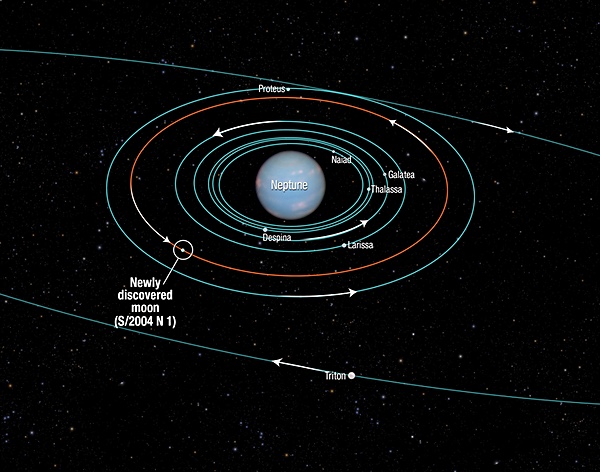 Triton orbits in the opposite direction of Neptune’s other moons, indicating that it is a captured Kuiper Belt Object. (credit: ESO/L. Calçada) |
When Voyager 2 imaged Triton, it revealed a relatively young surface, geographically speaking. Instead of ancient craters, it was smooth and covered with ice. Scientists did not expect that. Soon they spotted a greater surprise: dark smudges on the surface that seemed to flow in a certain direction. Planetary scientist Larry Soderblum speculated that these were the result of some kind of geothermal activity on Triton, perhaps geysers. And soon more images indicated that there were active geysers on Triton, with material spewing up from the surface and then taking a ninety-degree angle as it hit upper atmosphere winds. Geysers! And winds! On what should have been a cold dead rock!
This was when I fell in love with Triton. Both Neptune and Triton had surprised us. Much later I had the luck to work with Larry Soderblum and told him that I was impressed that he had discovered the geysers on Triton. He corrected me: he had not discovered the geysers, Voyager 2 discovered them, Larry had only explained what they were. And that was perhaps the Voyager missions’ greatest gift: the lesson that no matter where we go in the solar system, when we look at something new, we are likely to be surprised.
There are two prevailing theories about where those geysers come from. The first—and more mundane—is that sunlight is penetrating through the icy surface and heating up material below that bursts out through the ice as a geyser. The second theory has far greater implications. The theory is that Triton has a water ocean below its ice, like Europa, Enceladus, and possibly some other moons, and that internal heating is causing that water to burst out as geysers. That would mean liquid water, energy, and maybe minerals—the necessary ingredients required for life.
A few years ago, some scientists proposed a space mission named Trident that would fly past Triton. Their mission did not get selected by NASA, but it offered an intriguing idea: that if an ocean does exist under Triton’s ice, it could dramatically expand our definition of where life can form in the universe. Our current search for exoplanets is based on the theory that we want to detect planets in the “habitable zone” around other stars, defined as the zone where liquid water could exist on a planet’s surface. But now scientists are intrigued with the possibility that there could be life in oceans under the icy surfaces of Jupiter’s moon Europa and Saturn’s moon Enceladus. If there could be water, and possibly life, under an icy surface of a captured Kuiper Belt object, that means that life could exist far from a star. It may not be detectable ever, but it could change our concepts of what “habitable” means for planets. Life could be anywhere and everywhere.
Triton could be the key to a new definition of where life can exist in the universe.
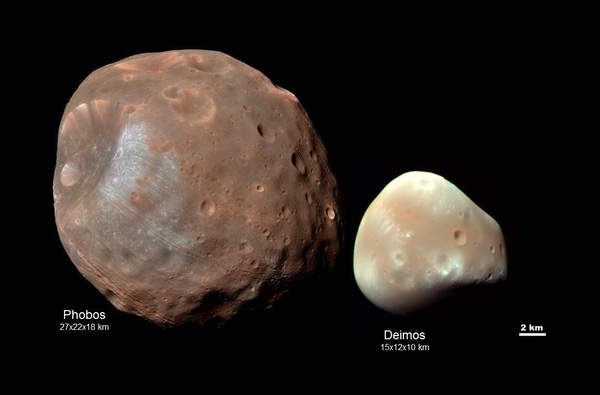 The two martian moons Phobos and Deimos are either captured asteroids or formed along with Mars or soon afterwards. A Japanese mission that will retrieve samples from Phobos should be able to definitively answer their origin story. (credit: NASA) |
Phobos
Phobos, like its sister Martian moon Deimos, is a mystery moon for many reasons. It also has a great backstory. Both moons share many characteristics with certain types of asteroids. This has led to the theory that they are captured main belt asteroids. One problem with this theory—a big problem, actually—is that they have very circular orbits that lie almost exactly in Mars’ equatorial plane. If they were captured, there’s no good reason to believe they would end up exactly at the equator, and therefore this requires a complicated explanation to unravel the mystery of how they ended up where they are. Another theory is that Phobos and Deimos coalesced in orbit after Mars formed, possibly as the result of a giant collision with Mars. That theory also has problems.
| A good sample returned from Phobos would answer the question of where it (and Deimos) comes from, whether it is a captured asteroid or a piece of the same stuff as Mars. |
Planetary scientists have many theories about the origins of many different objects in our solar system. But one of the aggravating things about science is that definitive answers are difficult to come by. Even after bringing hundreds of kilograms of samples back from Earth’s moon there is still disagreement on how it formed. But Phobos is different. A good sample returned from Phobos would answer the question of where it (and Deimos) comes from, whether it is a captured asteroid or a piece of the same stuff as Mars. We already have meteorites from asteroids and even meteorites from Mars. It would not be difficult to compare a sample from Phobos to those other samples and answer that question, solving that mystery once and for all. Fortunately, the Japanese plan on doing exactly that. Their MMX mission, for Martian Moons eXploration, is planned to launch in 2024, land on Phobos in 2025, and bring back samples by 2028. So we should have an answer soon afterwards. The answer will inevitably lead to more questions—that’s how science works—but the big question of whether Phobos and Deimos are captured asteroids or formed with Mars should finally be solved within a few years.
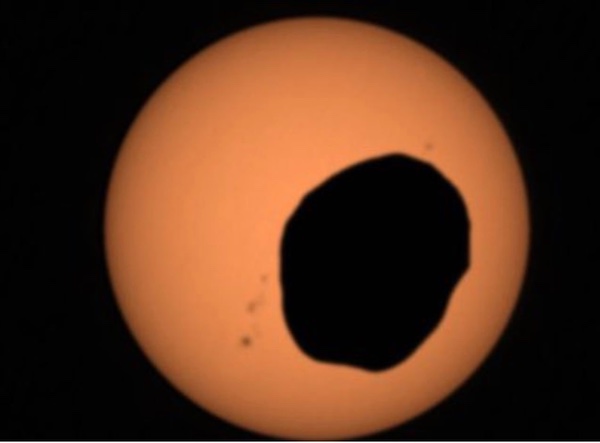 Phobos eclipsing the sun in a recent image taken from the surface of Mars. (credit: NASA) |
Phobos has proven to be a difficult target—several previous missions to the moon ended in failure. In July 1988, the Soviet Union launched Phobos 1 and 2 towards Mars. Phobos 1 was lost a few months later when it was accidentally shut off. Phobos 2 made it to Mars by January 1989. It returned some blurry images of Phobos, and then it stopped transmitting. In 2011, the Russian Space Agency launched Fobos-Grunt, a Phobos sample return mission. But the spacecraft, which had suffered numerous problems in development, immediately failed in Earth orbit. It’s almost as if Phobos is taunting us. MMX will now be the fourth dedicated mission to Phobos, and hopefully will be successful.
There have been many American proposals for robotic missions to Phobos over the years, with names like PANDORA, Aladdin, and HALL, but none were selected, so Japan’s decision to fly a mission has probably made a lot of American Phobos aficionados happy, even if they wish they were doing the mission themselves. (I am planning on writing an article about Phobos mission proposals and am interested in hearing about past concepts.)
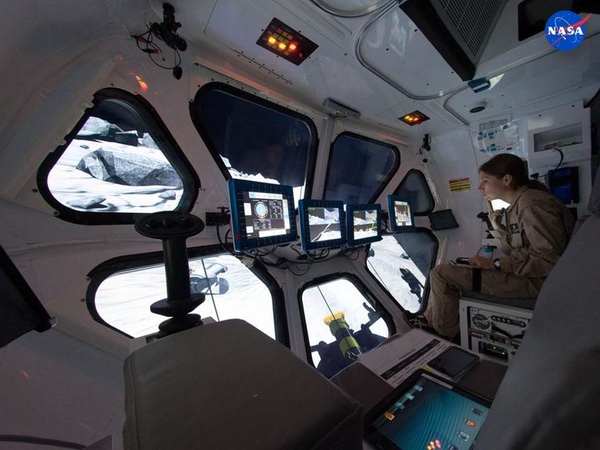 In 2015–16 NASA studied how a human exploration of Phobos could take place. One option was a dedicated excursion vehicle that would essentially rendezvous with the moon. (credit: NASA) |
In 2015, a NASA team at Johnson Space Center also studied how astronauts might explore Phobos if they were already in Mars orbit. The moon’s very low gravity makes human exploration tricky. The team determined that a spacecraft that could touch down on Phobos and enable astronauts to collect samples using robotic arms would be useful. Astronauts could also perform EVAs while still tethered to the spacecraft and using maneuvering units.
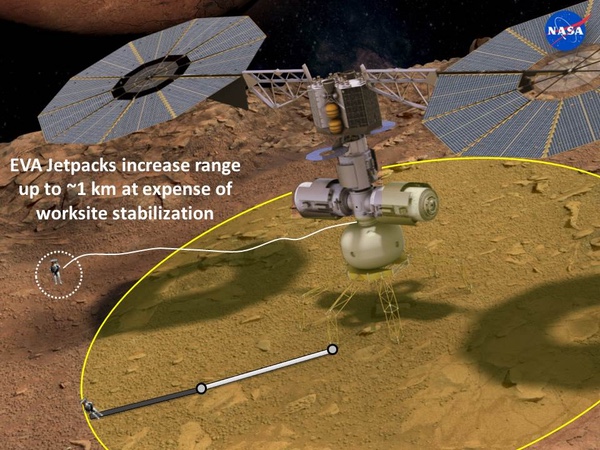 The 2015–16 NASA study of the human exploration of Phobos sought to address how astronauts could collect samples while still staying safe in Phobos’ very low gravity. Options included tethers, robotic arms like those used on the space shuttle, and maneuvering units. (credit: NASA) |
Phobos has featured a number of times in fiction. The 1966 book Colossus, by Dennis Feltham Jones, spawned the 1970 movie Colossus: The Forbin Project, about a supercomputer that takes over the world. The book had two sequels. In The Fall of Colossus, humans manage to shut down the Colossus computer, but when they do, they learn that the two moons of Mars are suddenly heading towards Earth, and are apparently alive. In the third book, Colossus and the Crab, humans discover that Phobos and Deimos are sentient machines, like Colossus, and they enslave humanity.
No comments:
Post a Comment